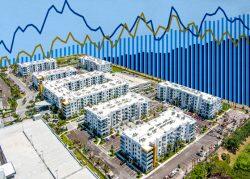South Florida’s multifamily party may be coming to an end. The market softened in the second quarter, and is expected to further slow by year-end, according to a recently released report.
In the second quarter, occupancy dropped across all South Florida submarkets, with the region averaging 95 percent, down 2 percentage points from last year, according to the report from Berkadia. In turn, landlords gave in to concessions, offering a month’s free rent or a discount on fees such as pet deposits.
On the investment sales side, South Florida felt the squeeze from high interest rates, with deal volume dropping 72 percent, year-over-year in the first half of this year, a comparison of Berkadia’s multifamily reports shows.
The drop follows a supercharged market led by population influx that started in late 2020, prompting unprecedented rent growth, development flurry and a sales spree. The thriving tri-county market outperformed the rest of the booming Sun Belt, at one point scoring the nation’s biggest rent hike.

“People were completely pushing the envelope to what was achievable, pushing $4 a [square] foot [in rent]. Some properties were even getting $5 a foot,” said Scott Wadler, of Berkadia. Since then, some properties “have leveled off in occupancy, and they are giving up rent a little bit.”
The construction spree continues to add supply, even as residential influx is more of a trickle. Developers, emboldened by the hot market of the past two years, are slated to bring over 19,000 units to South Florida by the end of this year, according to Berkadia. That would be more than the projected absorption of 12,000 units.
But brokers aren’t worried. Berkadia reported that leasing rebounded from last year, with nearly 2,400 leases signed in the first half of this year. Plus, the additional supply and resulting leasing slowdown are exactly what the scorching market needed to cool off. New units coming on line this year could further increase vacancies, but not for long, they say.
“Dropping from 97 percent occupancy to 95 percent is really more of a normalization,” said Roberto Pesant of Berkadia. “Moreover, very few projects are starting construction this year, so any downward pressure will be temporary.”
Rent reprieve? Not exactly
For years, many longtime South Floridians were housing cost-burdened, paying more than 30 percent of their income for rent and utilities. They really felt the squeeze when out-of-state residents descended on the tri-county region, heightening competition for units and causing the never-before-seen rent growth.
At issue: Florida incomes have long lagged behind those of New York and California, from which a good portion of the Sunshine State’s transplants hail. (Miami-Dade County’s area median income is $74,700, less than New York County’s $94,400 and Los Angeles County’s $98,200, according to the Department of Housing and Urban Development.)
Despite the recent market slowdown, locals aren’t in for a reprieve.
Landlords continued to increase rents in the second quarter, with South Florida rates averaging $2,500 a month, up 6.3 percent year-over-year, Berkadia’s report shows.
Downtown Miami and South Beach rank as the most expensive markets. Effective monthly rent, or what landlords collect after concessions, increased 7 percent in the second quarter, year-over-year, to $3,280, according to Berkadia. North-central Miami experienced the biggest rate increase at 19.4 percent, with $1,825 in effective rent.
Palm Beach County was the only submarket where rents dropped, slightly, by 0.2 percent to $2,520, according to Berkadia. In the second quarter, rents in the Margate-Coconut Creek-North Lauderdale submarket remained flat at $2,235. That puts the region among the top markets for rent growth, with the fourth highest average effective rent on the East Coast.
Still, residents on the hunt for a unit have a bit more power to negotiate amid the drop in occupancy. Concessions are up, with 8.7 percent of South Florida units offering some reprieve on rent and fees in the second quarter, according to Berkadia data. That is up from 7.3 percent in the first quarter, 5.6 percent in the second half of last year, and a record low of 4.7 percent in the first half of last year.
Even new apartment buildings in prime areas aren’t immune to concessions. The 306-unit Dorsey has been offering a month of free rent on a 13-month lease since at least early June, according to the project’s website.
The Pérez family’s Related Group, Alex Karakhanian’s Lndmrk Development and Tricera Capital completed the 12-story Dorsey at 286 Northwest 29th Street in Miami’s Wynwood last year.
“A robust development pipeline, particularly in the luxury asset class, could push concessions higher and further slow effective rent and occupancy growth,” Berkadia said in its report.
Deal? More like no deal
In the first half of this year, investors paid a combined $1.1 billion for South Florida multifamily projects across 11 deals, paying an average of $341,000 per unit, Berkadia’s report shows.
That’s a far cry from the $3.9 billion in investment sales in 33 deals during the first half of last year. At the time, the average price per unit was $419,300.
Deals were muted this year, as bid-ask gaps emerged when buyers facing expensive financing costs couldn’t pony up as much as sellers expect for apartment buildings that are well-leased at high rents.
Overall, the lack of competition has pushed South Florida multifamily property prices down by 25 percent to 30 percent compared with last year, said Hampton Beebe of Newmark.
That opened the door for an investment sale pickup in June, when buyers with closed discretionary funds needed to deploy capital. Among them: Harbor Group International, which this summer bagged the 280-unit Locklyn West Palm apartment complex at 3590 Village Boulevard in West Palm Beach for $105.5 million.
Also, Praedium Group paid $138 million for the 348-unit Manor Lantana complex at 861 Water Tower Way in Lantana in June.
Firms using discretionary funds for purchases “are very conservative and patient,” Beebe said. “Praedium, Harbor Group … these are groups that have invested in South Florida for decades. When you get to a certain price point, it’s very attractive.”
Investors that jumped into South Florida during the market’s high in the last two years will face competition for renters due to new supply, as well as much slower rent growth than during the past two years, experts say.

But don’t worry too much about them, said Berkadia’s Pesant.
“Those investors did capture at least some percentage of the region’s roughly 30 percent rent growth in 2021, and roughly 15 percent rent growth in 2022,” he said. “At the very least this provides a decent cushion in light of the new inventory.”
Read more


